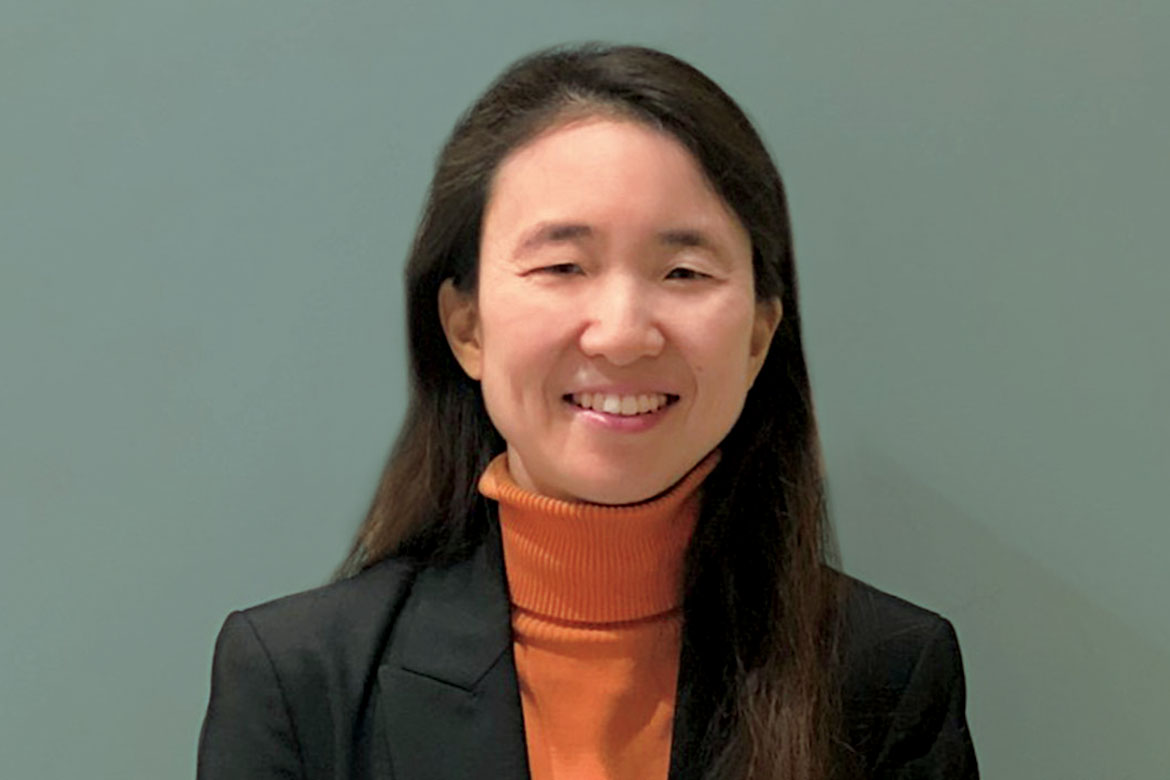As a daughter of immigrant parents and a first-generation U.S.-born citizen, AMA member Elisa Choi, MD, an internist and infectious-disease subspecialist, always had an affinity for biological and life sciences.
But she also gravitated to the humanities, pursuing an English degree in college while studying life sciences and typical pre-med courses. Having studied English in college proved to be helpful in Dr. Choi’s career in medicine, ultimately guiding her to better understand her patients’ narratives and enhancing her ability to communicate important health information while advocating for health and gender equity.
In 2018, Dr. Choi became the first woman and only Asian American female elected to serve as governor in the history of the Massachusetts American College of Physicians (MA ACP) chapter. Currently the immediate past governor—with her governorship term having ended in April—Dr. Choi now serves as the chair of the ACP board of governors, and is also a member of the ACP’s delegation to the AMA House of Delegates.
“Part of being a woman in medicine is recognizing how far we've come today with advances made by women in medicine, yet acknowledging how much further we have to go,” said Dr. Choi. “At the time when I was elected, I found out I was the first woman elected to governor in the entire history of the Massachusetts chapter of the ACP. For that to happen, though, was due to serendipity and timing.”
“Since that time—in addition to my commitment to health equity—advancing, supporting and amplifying women in medicine has been a personal passion project of mine because once I realized I was the first woman elected as governor, it was amazing to me that in the nearly 100 years of our MA ACP chapter, that had not happened before,” she said. “That led me to initiate a project that I shepherded throughout my governorship, which was a leadership development for women in medicine project.”
“The whole concept there was to better understand: Why aren't there more women in leadership roles?” Dr. Choi said. “Women currently make up a little bit more than half of the medical students, and things will change hopefully in the next several decades, as those women medical students then become women resident and fellow physicians, and then become early career women physicians and then move onwards professionally.
“But there is a tremendous disparity in the percentage and proportion of women in leadership roles currently, particularly in senior leadership roles, compared to the proportion of men who hold those roles,” she added.
Every September, the AMA celebrates women physicians, residents, and medical students during Women in Medicine Month. The theme this year is Women in Medicine Month: Leading with Purpose.
In an interview with the AMA, Dr. Choi discussed how she continues to address health and gender equity and how she leads with purpose to advance women in medicine. The thoughts and opinions expressed in this article are exclusively Dr. Choi’s, and are not necessarily official policies or positions of any organization with which she is affiliated.
AMA: You have taken on many leadership roles. As a woman in medicine, how important is it to take on these leadership roles?
Dr. Choi: It's important to take on these leadership roles so that younger women who might be thinking about pursuing advancement in their profession and advancing into leadership roles can actually see another woman in that role. If we can't see it, it's really hard to imagine it. So, for me, it's both a way for me to continue to develop professional skills, because there's so much to learn about how to manage people, how to mentor, how to sponsor, and how to teach, in taking on various leadership roles. But it also is a little bit of a force multiplier. You have a woman in a leadership role. She may be more likely to then nominate and support other women for other leadership roles. Then suddenly, when previously there was only one woman in leadership, there now may be five women leaders, and then that may branch out to 10 women leaders, as each woman in leadership sponsors additional women to advance into leadership roles. What I had noticed in the Massachusetts chapter, and I won't claim sole credit for this, but I will acknowledge that perhaps seeing me in a governor role, for many women chapter members it felt more welcoming to them, to then step up and step into other MA ACP chapter leadership positions.
One of the main goals that I focused on during my governorship was to advance women in medicine. During my governorship, our chapter’s Governor's Council became much more gender balanced. As governor, I also had the opportunity to nominate people into various leadership roles in the chapter. I was able to look around and ask, “Has there ever been a woman in that leadership role?” or “Are we gender balanced in this particular committee?” Ultimately, toward the end of my governorship tenure, virtually every single committee and subcommittee was either chaired or co-chaired by a woman physician leader.
Women in leadership roles help get more women into leadership. That’s one way we can achieve gender equity and gender balance in having leadership that reflects our population, which is half comprised of women.
AMA: How do we achieve that gender balance?
Dr. Choi: We have to be intentional about it. One of my goals is to be very intentional, focused and directed, regarding gender equity, and take a look—has there ever been a woman in this role? Has there been an opportunity for a woman? If there has not been, then trying to make and create those opportunities for future women leaders is a priority for me. I'm really happy to highlight that increased gender equity has also occurred in the ACP national arena. There haven't been that many women chairs of the ACP board of governors, and I believe I'm the first woman of pan-Asian heritage to serve in this role. But for the first time in ACP history, my immediate predecessor (the immediate past chair of the ACP board of governors), myself (as current chair, and my immediate successor (current chair-elect of the ACP board), are all women. This is the first time in ACP history that three years in a row, it will be a woman serving as chair of the ACP board of governors. Other firsts for ACP national—our current ACP treasurer is a woman—first time that's ever happened in ACP history. We now have a parliamentarian for our ACP board of governors who is a woman. That’s the first time that’s happened before too. Our ACP CEO is a woman. When she stepped into that role several years ago, that was the first time a woman held that top leadership role in ACP. So, there's just so many firsts for women in medicine in ACP national recently.
It is so important for women to take on these leadership roles so that other women see that it's possible. Then the women in these leadership roles are very likely to promote, amplify, support, mentor, and sponsor other women to then create more women in leadership roles. So, this continued pathway for fostering more women leaders is incredibly important.
AMA: What other ways do you work to advance gender equity in medicine?
Dr. Choi: I am trying to be available particularly for medical students, resident and fellow physicians, and young career or early career physicians who may need somebody to just be an informal guide or a mentor. I try to be accessible and try to instill confidence. I've been really fortunate that there have been opportunities to do that informal mentoring.
I recently was extremely honored and surprised to find out I was nominated for an AMA Women Physicians Section Inspiration Award. It is tremendously gratifying to me that somebody who felt like I was able to inspire them, nominated me. That's incredibly meaningful.
In my day-to-day work, whenever I see women who appear to me to have leadership potential or aspirations, I want to try and boost their confidence because women generally have more of an imposter phenomenon that they face than men. This leads to women being more reluctant to put their hat in the ring for leadership positions, and also being less likely to take career leaps that may be considered ambitious because they feel like they may not be qualified enough.
My hope is that even on an individual level with any woman that I know who is a colleague and a fellow professional who has leadership aspirations, I can be that voice in their ear saying, “You've got this, you're going to be great. You should put your hat in the ring for whatever it is you are considering.”
Also, I am a chief of my department, and I try to be as encouraging as possible for the women in my department. In hiring women, I also try to support women physicians and clinicians, for both their professional aspirations but also their work-life balance interests. I'm fortunate that I have numerous platforms to promote gender equity and support women in medicine in different ways.
AMA: The theme this year for Women in Medicine Month is leading with purpose. How do you lead in with purpose?
Dr. Choi: One way I lead with purpose is—I try very hard when I'm in a leadership role to listen as much as, and actually more than, I talk. That has taken a lot of work and I won't claim to be perfect at it. But, I do feel that is one way I try to lead with purpose because, ultimately, the best leaders care less about the title and position, and care more about being able to support and represent the people for whom they hold a leadership role. You can't support people unless you really understand where they're at and what they're experiencing and going through. Part of leading with purpose, in addition to trying to be as active and supportive a listener as possible, is to take a look around at the table—whether it’s the table one is sitting at, or the figurative table of one’s professional network or thinking about who has preceded me—and identify who hasn’t yet had the chance to have a voice at that table, and determine what I can do to then make sure that people who haven’t yet been represented will be in the future.
Other forms of representation, beyond nominating and sponsoring people for leadership roles, includes nominating individuals for awards or picking them as keynote or featured speakers. Being a speaker at a conference or at a meeting is also a position of high profile. For audience members, seeing a person in a very visible role as a public speaker, who may represent a particular gender, racial or ethnic group, sexual orientation, or whatever other category, can be very energizing, inspiring and affirming for folks who may share similar backgrounds to those speakers. It is a form of representation, and representation definitely matters. I also lead with purpose with principles of justice, equity, diversity and inclusion as my guide. I like to use the acronym “JEDI,” for these four principles. I'm not the only one who has used that acronym of “JEDI”, as I know many of my own personal “sheroes”—mentors and sponsors—have used that term. I like to think of JEDI goals as guiding principles.
A big part of leading with purpose is to consciously and intentionally think about what I can do to promote JEDI principles, and what can do in my various leadership roles every day to make sure that JEDI is happening. We still do have a long way to go to achieve equity.
If I am a “first” for anything, then we have a lot more work to do because there were decades where there were opportunities for others before me to be a first. So, for me, being a “first” for anything just shows how much more we need to do to achieve JEDI, and is a sign that we can't get complacent. But it is also an opportunity to make more positive change in the future.




